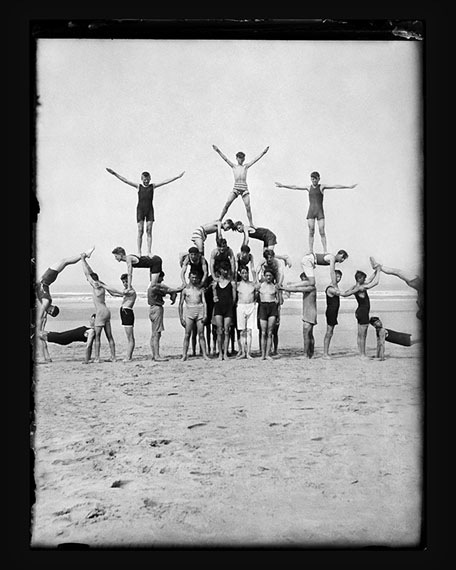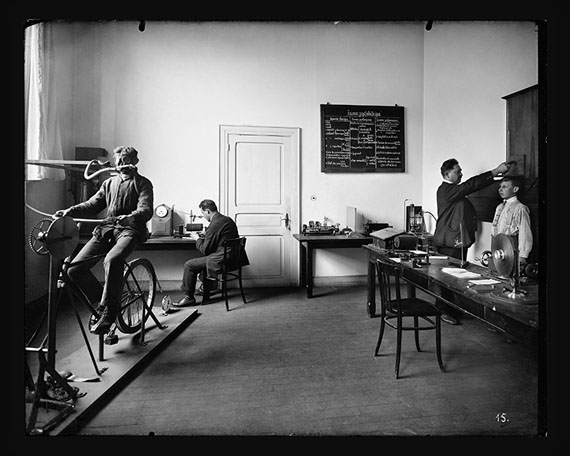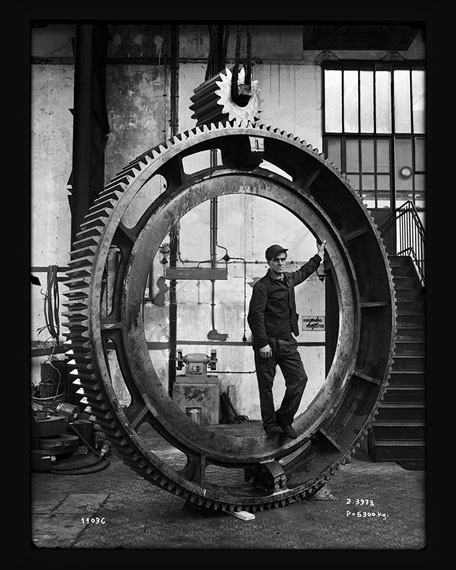
Swedish gymnastics on the beach. Around 1928
© CNA, Fonds Institut Emile Metz, HISACS000207V01
Forging a Modern Society
Photography and Corporate
Communication in the Industrial Age,
ARBED 1911?1937
Exhibition: 10 Jun – 17 Dec 2017

CNA Centre national de l'audiovisuel
1b, rue du Centenaire
3475 Dudelange
+352-522424-1
Wed-Sun 12-18

The psycho-technical laboratory. Around 1922
© CNA, Collection Institut Emile Metz, HISACS000714V01_3074_15
"Forging a Modern Society"
Photography and Corporate
Communication in the Industrial Age
ARBED 1911−1937
Exhibition: 10 June – 17 December 2017
"Forging a modern society" showcases a collection of glass plate negatives and positives from an industrial archive and pieces together the journey they have taken over time. These photographs from the era of industrialisation, discovered in 2007 at the Lycée Technique Privé Emile Metz in Dommeldange and featured in an exhibition at the Centre national de l’audiovisuel (CNA – National Audiovisual Centre), have had a long and varied history, serving a multitude of social purposes and being reproduced in different contexts.
Created as tools for corporate communication in the first half of the 20th century, the glass plates soon became relics of Luxembourg’s industrial history, a visual representation of the development of the Institut Emile Metz and ARBED Dommeldange over time. After being donated to the CNA, they underwent meticulous archival work and digitisation and were carefully restored by students from the Hochschule für Technik und Wirtschaft (HTW – University of Applied Sciences) in Berlin. The HISACS Institut Emile Metz collection is now part of Luxembourg’s visual cultural heritage and has been made available for research purposes. In 2012, the glass plates were the inspiration for the FAMOSO research project – Fabricating Modern Societies: Industries of Reform as Educational Responses to Societal Challenges, based at the University of Luxembourg. The Institut Emile Metz photographs opened up new avenues for research and investigation, and thanks to the concerted efforts of the CNA and the team of researchers at the University of Luxembourg, their cultural significance has now been fully recognised. Above all, they are a vibrant witness to a fascinating chapter of history, one full of details and anecdotes that continues to hold a real relevance and resonance for us today.

The training workshops: training in using a file. Around 1922
© CNA, Fonds Institut Emile Metz, HISACS002044V01_185
As well as showcasing this precious collection of glass plates, the Forging a modern society exhibition is an opportunity for the CNA to provide a glimpse of the work that goes on behind the scenes at a cultural institution and public archive. The HISACS Institut Emile Metz collection is an example of the long journey taken by a series of photographic objects, from their initial inspection by archivists, via the work of restorers and digitisation specialists, to their use as the focus of scientific research, an exhibition and a catalogue. The story of this collection also hints at its potential as a basis for further challenges, as the images take on new forms and are used and featured in future research, events and publications.
Catalogue published on the occasion of the exhibition
La Forge d'une société moderne
Photographie et communication d'entreprise à l'ère de l'industrialisation
ARBED 1911 – 1937
Editors : Marguy Conzémius (CNA), Françoise Poos (C2DH), Karin Priem (C2DH)
Publisher : Centre national de l’audiovisuel (CNA), Luxembourg, 2017
ISBN : 978-2-919873-20-3
Languages : Français, English
Price: 35€
Available at http://eshop.cna.public.lu

products: gearwheels. Around 1950
© CNA, Fonds Institut Emile Metz, HISACS000849V01_11036_Z_3973